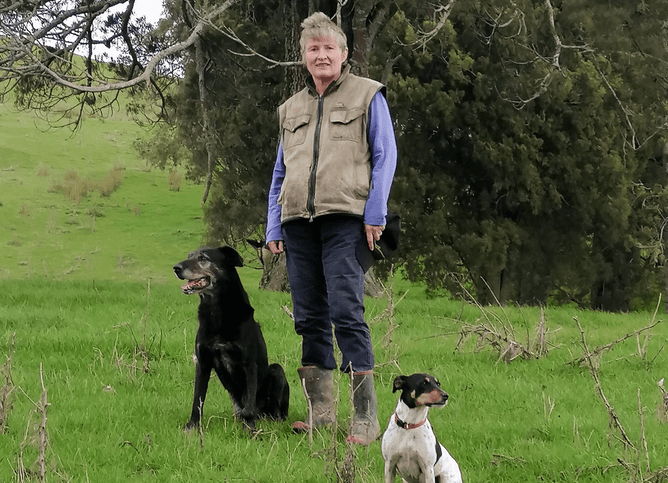Sally Lee has been a skilled FARMAX user for many years, using FARMAX not only for her own farm, but in a consulting capacity as well.
Sally has run Burklee Farm for the last 14 years in an equity partnership that has “worked absolutely fabulously” and has thrived under her management, increasing the lambing rate from 80 percent to 140 percent in the first five years on farm.
Burklee consists of two blocks in the hill country between Port Waikato and Raglan, with only 14 percent of flat to rolling land and the rest medium to steep hill terrain.
Farm policies have changed considerably throughout the years, with current numbers sitting at 850 maternal ewes and 850 terminal ewes. Traditionally, they have had Suffolk sheep, but this year they have a mix of Suffolk, Dorsets and Meat Makers.
The aim is to maintain approximately a 50:50 sheep to beef ratio. The beef component was originally dairy grazers and lease bulls, and now a combination of trading cattle, with a focus on bull finishing.
Burklee gets very dry during the summer months and can be particularly hard on young stock, so she tends to go for the older, more hardy stock, buying them at 18 months and taking them through to 300kg carcass weight.
A raft of information
FARMAX has been an integral part of the farm management for years, with Sally introducing FARMAX “right from the word go”.
“We we’re pretty good monitors for the first ten years, then we probably got a little bit slack,” laughs Sally.
Now, she uses FARMAX more for analysis, but the in-depth historic data they have recorded is invaluable for doing accurate forward planning and is also useful for annual quality assurance (QA).
“We basically show them what we're doing on FARMAX…we bombard them with information and they’re bamboozled, it’s so easy. It’s assurance that we are recording and monitoring and things like that, so we normally get through the QA process quite quickly,” explains Sally.
Sally finds FARMAX a good tool for confirming her theories before putting them in place:
“When is my best time to put on nitrogen if I was going to put in on? Sometimes I realise that it doesn't give me very much bang for my buck so why put it on?”
FARMAX is also great for seeing how the farm has progressed over time – a record of everything they have done to get to where they are.
Sally’s message to anyone starting FARMAX is that the first couple of years of recording are the hardest.
“That first two years of monitoring is actually really crucial, and if you can get through those first two years, then you’ll be away flying!
“The data you’ve got in FARMAX is far more accurate. I think people think their weights and pasture growth are far better than they really are – that’s hard to be confronted with the truth,” Sally says.
But getting the right data into FARMAX sets you up with an accurate base and a true representation of your farm, which is essential for future planning.
The way forward for Burklee will just be tweaks to the almost optimum farm system they have created – things like forestry planting, changing ram breed or altering the timing of selling; “trying to take opportunities when they arise”.
"That first two years of monitoring is actually really crucial, and if you can get through those first two years, then you’ll be away flying!"
- Sally Lee, Burklee Farm
A lighter footprint
Sally also uses FARMAX as a consultant as part of the Wai Kōkopu project: a community-led programme to replenish and restore the Waihi estuary. The three-year programme – funded by the Ministry for Primary Industries – is currently in its second year.
There are 15 Lighthouse farmers in the catchment, a mixture of dairy, sheep, beef, kiwifruit, avocadoes and forestry, all passionate about revitalising their local environment and increasing their farm’s sustainable practices.
The group meets four or five times a year to share their experiences, what they’ve learned and what they hope to achieve.
“What we've done with this is we've taken their data – we started in 19/20 – and we analysed it to what they're doing now and then we modelled systems for their farm, such as reducing fertiliser, supplement feed, stocking rates to lower their outputs such as nitrogen and greenhouse gas,” says Sally.
She asserts that it is all about creating a lighter footprint while ensuring the farms stay profitable, and that is where FARMAX is extremely useful.
Sally explains: “I run a whole lot of models through FARMAX – we present three main ones to each farmer that meet the goal. Then I run that through OVERSEER as well and collect a number of key KPIs. The two programs run in unison with each other.”
Some of the farm scenarios Sally is looking at include lowering stocking rate, creating hybrid systems, decreasing the amount of nitrogen used and changing rates of supplement feeding.
When one farmer wanted to convert his farm from dairy to beef, Sally created his ideal farm system: “By entering the components of the farm system into FARMAX, it showed me that the system couldn’t work. Working through the scenario with him and providing feedback as we worked through the season, he has now modified his system to accordingly.”
While the work is well worth it to improve the water quality surrounding the farms, Sally says the hardest thing is hearing from the farmers that they’ve made the changes, but aren’t seeing the results in the water quality.
The positive is that each of the farmers are making incremental changes in their farm systems and that, accumulatively, they will be having an impact both on water quality and their on-farm profitability.
“We could be in a 5 – 10 year lag here – we’ve got to keep the enthusiasm going.”
For more information on Wai Kōkopu, head to https://www.wai-kokopu.org.nz/.

